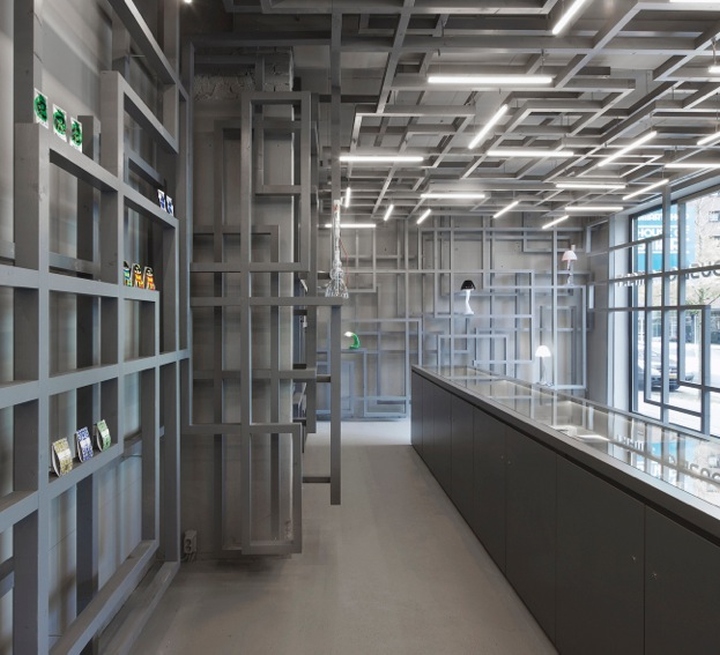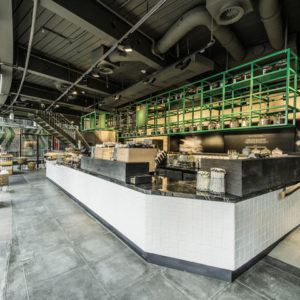


The centre of Eindhoven is graced by the addition of a new high-profile shop interior. The House of Smart opened its doors on 29 September, right across from the Witte Dame building. The shop has been designed by Maurice Mentjens, who has several other smart shop designs to his name. The brain-like structures of the panelling have been inspired by the interconnectedness of the neural pathways of the brain.

‘A smart shop is a shop like any other retail establishment selling stimulants,’ emphasizes the brand-new owner of House of Smart. ‘No secrecy is necessary; rather, we should be more open about it.’ In the architectonic design, this opinion is translated into large display windows that offer the passer-by a good look at the streams of thought within this House of Smart. Product samples are placed in strategic locations. The entire interior, including the ceiling, has been panelled with a criss-cross of wooden structures. The sober palette of shades of grey combines with the panelling to create the image of the cerebral cortex, the part of the brain where all information is processed.

The abstracted brain
Maurice Mentjens always searches for inspiration in the genius loci; the local context or spirit of place. For this design it was the DNA of Eindhoven as the technological centre of the Netherlands. ‘In 2011, Eindhoven was declared to be the “world’s smartest region” by the Intelligent Community Forum (ICF). This is in no small measure due to initiatives such as “Brainport Region Eindhoven.” This is why it seemed interesting to me to represent the brain with its branching nervous system in an abstract manner in this particular location. It is like a labyrinth or a maze. But you can also interpret the branching as the wiring of complicated printing plates or computer chips, symbolic of rational thought and artificial intelligence.’

Rationality, intuition, and illusion
But that’s not the whole story. Mentjens’s designs are characterized by their layered nature. Behind the first, superficial impression, a wealth of spiritual associations emerge that illuminate the design concept. In this case, that is the contradiction between rational thought and the psychedelic experiences of mind-expanding substances.
Maurice Mentjens explains, ‘People who are open to it understand that there is more between the heavens and the Earth than the pre-conditioned perceptions of our culture. The realm of creativity is chaos and does not proceed along linear thought patterns. An open mind is of vital importance for true renewal. The conceptual relationship between rationality, intuition, and illusion are essential to this. This was the credo of the hippie movement of the 1970s in their search for other dimensions. But this was also highlighted by leading artists and academics who think outside the box like Jean-Paul Sartre, Ettore Sottsass, and Steve Jobs. These free spirits followed in the footsteps of the shamans who used mind-expanding substances for their transcendental travels to other dimensions and parallel universes. In this context, the statement on US artist Bruce Nauman’s neon spiral “Window or Wall Sign” (1967) is particularly poignant: “The True Artist Helps the World by Revealing Mystic Truths”.’

Iconic interiors
Mentjens has unleashed his creativity on the design of smart shops before. The iconic Sirius smart shops in Maastricht, Roermond, and Eindhoven are famous, and are all linked to the history of the city. The first appears like an alchemy lab and the second shop makes reference to the spiritual function of churches and chapels. But at the Eindhoven branch holographics are the central theme in honour of the lighting industry that used to be located here.
In this new House of Smart, it is all about the net-like structure of the brain, partly used here as a display case. On the 65-mm wooden beams, samples are hung like the fruit on the Biblical tree of the knowledge of good and evil. For the presentation of more valuable items, there is the option to install glass cases in the construction.
The two right-angled counters also serve a display purpose. Their large size but camouflaging shade of grey means that they share this space without being too obvious. The same theory applies to the lighting provided by minimalistic LED beams that seamlessly blend in with the all-encompassing structures.

The connecting power of building traces
For the renovations, the early-20th-century building was completely stripped down to its bare walls, including the removal of the unsightly white wall paint that drenched the characteristic façade. The glazing bars of the windows were also removed. The front door made way for a taller model that is better suited to the large display windows. After all the demolition work, in the interior only the loose-hanging parts were removed. ‘The roughly bricked walls bearing the traces of renovations and breakthroughs of the past were purposefully left visible. Somewhere in that wall there is even an old safe!’ The history of the building is written on its walls, a detail that Mentjens feels strongly connected to. ‘It is the ultimate way to connect a new design to time and space.’
Design: Maurice Mentjens
Photography: Arjen Schmitz

About Maurice Mentjens
Maurice Mentjensprimarily designs interiors and related objects and furniture. The designs are almost exclusively for the project-based sector including shops, restaurants, office interiors, and museums. The aim is to create high-end designs with a small dynamic team of enthusiastic and talented staff. Quality and creativity are our top priority in all the aspects of the design process and its completion. The design agency is the three-time winner of the Dutch Design Award and received the 2007 Designpreis der Bundesrepublik Deutschland (‘Design Award of The Federal Republic of Germany’). Our clients include the Bonnefantenmuseum in Maastricht, the Frans Hals Museum in Haarlem, Post Panic video producers Amsterdam, DSM head offices in Heerlen, and Amsterdam Airport Schiphol.








Add to collection










